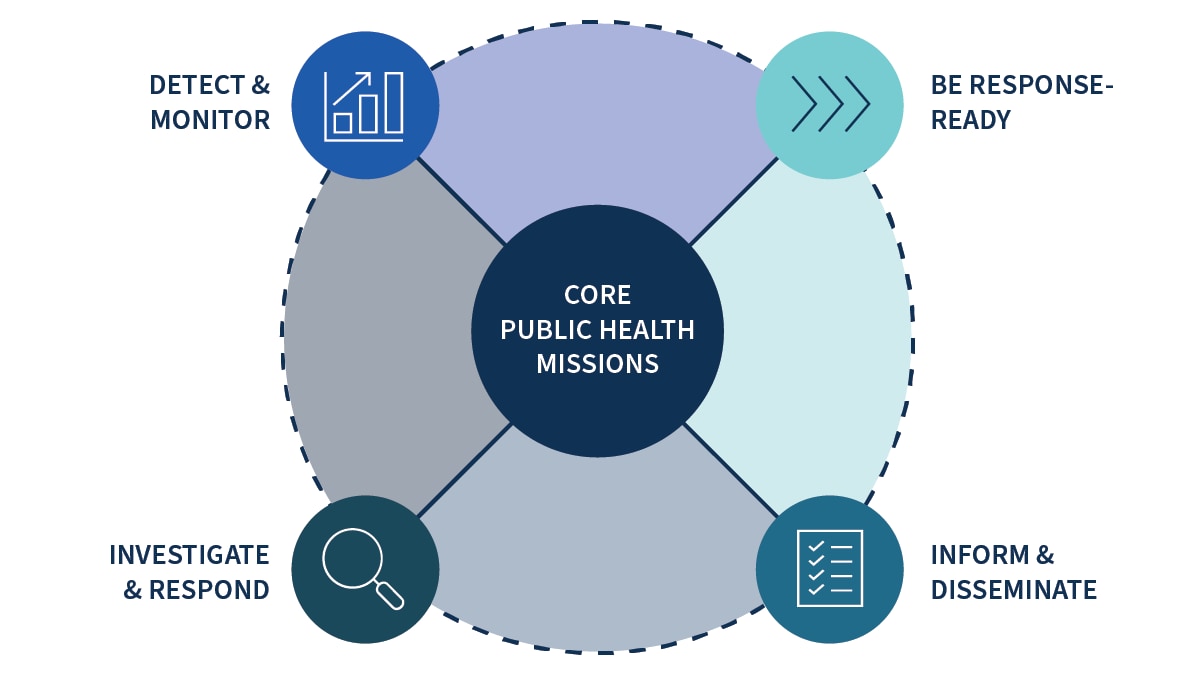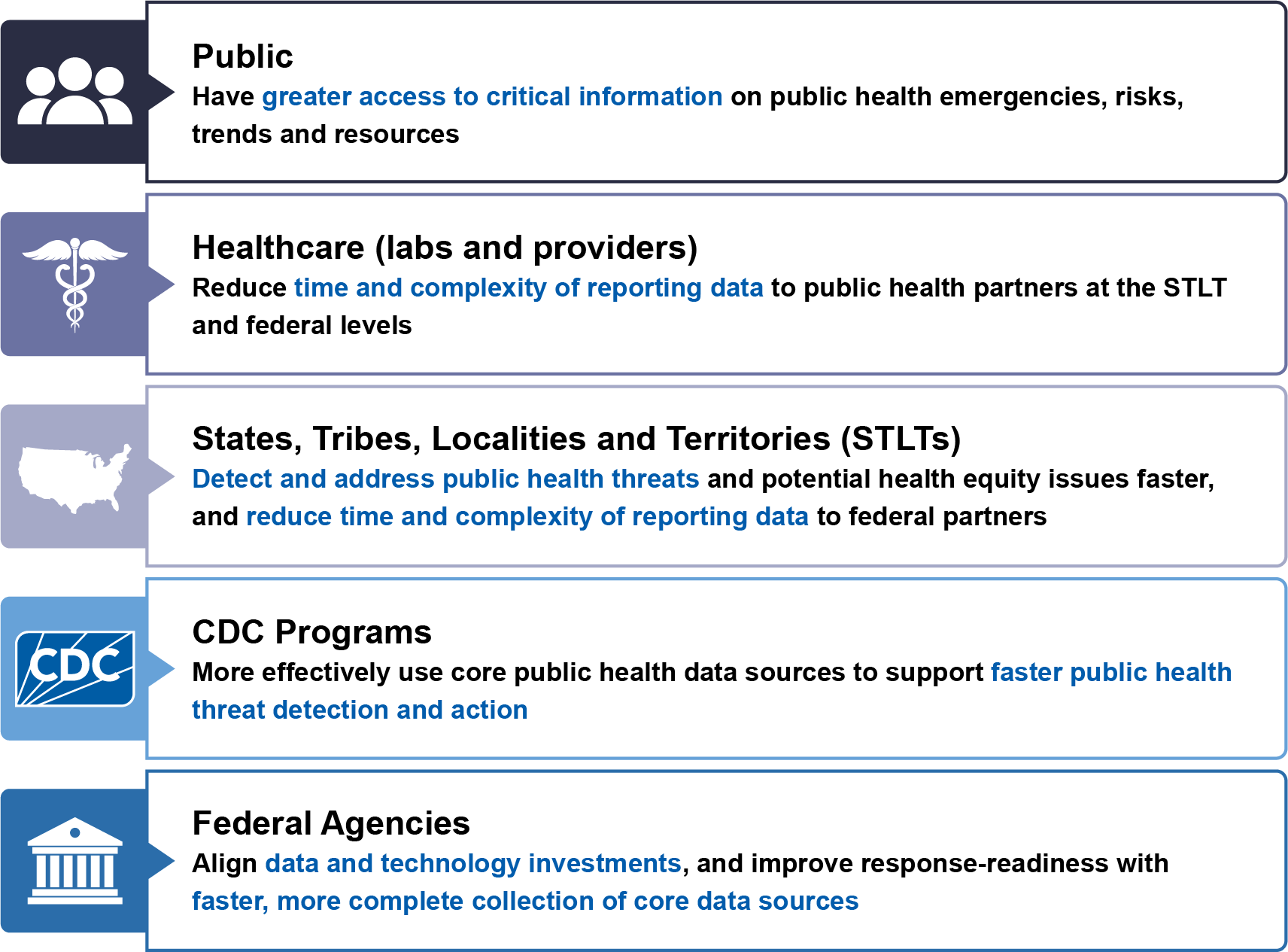At a glance

Foreword
The PHDS, first launched in 2023, is part of a groundbreaking undertaking to modernize the nation's public health data systems. The vision is the creation and sustaining of a critical national security asset: a robust, interconnected data infrastructure, ready to detect and respond to any health crisis.
CDC and its partners at the federal, state, local and private sector levels began this data modernization journey in earnest in 2020. Data drives our nation's ability to spot threats early, intervene rapidly and promote health. But outdated technology, cumbersome processes and siloed, disconnected systems were keeping data from moving faster than disease. Bolstered by significant investment from Congress in 2020, CDC and its partners began to bring public health data into the modern era.
Making Progress
Public health has made significant progress in modernizing its data systems. Many core data critical to early detection and monitoring are now exchanged automatically and quickly. These core data sources cover greater numbers of the American population and are more easily shared with partners and the public.
Solutions to the hardest data exchange problems are within reach thanks to steady progress of system modernization and adoption of common standards.
88%
Nation's emergency department visits available for situational awareness, most within 24 hours.A
700,000
Anonymized commercial lab tests received per day, covering 167 conditions.A
69%
Of deaths from provisional mortality data received within 10 days, up from 11%.A
1,500+
Wastewater reporting sites for COVID-19, flu, RSV and mpox.A
Ensuring Efficiency, Reducing Burden
At a practical level, the PHDS is making data exchange fast, efficient and less burdensome for everyone involved when and where available technologies and capacities are used. A clinician spends less time on manual reporting and more time treating patients. An epidemiologist spends the day investigating hepatitis cases instead of entering them into a spreadsheet. A researcher combines millions of data points to better understand heart disease. State-of-the-art dashboards integrate myriad data sources into a single view, helping decision-makers see where to allocate resources to meet greatest needs.
Expanding and Adapting
This 2025 update reflects improvements that build on our progress, adapt to evolving needs and remain feasible with available resources. It also introduces a major new milestone: establishment of a central data platform that can support both routine public health surveillance and emergency response needs with speed, efficiency and transparency. The One CDC Data Platform (1CDP) will include a shared, secure workspace where CDC and public health partners can collaborate and access core data and reusable tools.
Together with our partners, we are creating a nimble, sustainable system that helps detect threats promptly and monitor them in real time. We have more work to do, but this work is doable—with diligence, partnership and sustained resources.
PHDS Overview
The PHDS outlines specific data, technology, policy and administrative actions essential for fast, efficient and secure exchange of public health data across health care and public health. Seamless sharing of data helps ensure our nation can rapidly detect and respond to threats, promote health and save lives.
The strategy sets four overarching goals:
- Goal 1: Strengthen the core of public health data.
- Goal 2: Accelerate access to analytic and automated solutions to support public health investigations and advance opportunities for all people to attain their highest level of health.
- Goal 3: Visualize and share insights to inform public health action.
- Goal 4: Advance more open and interoperable public health data.
Each of these goals has a set of specific, timebound milestones to measure progress, enabling accountability and transparency.
The PHDS aims to solve the big problems that have hindered data exchange between public health and health care, and within public health:
- The disconnect between public health and healthcare IT.
- The siloed systems across public health and within CDC.
- The manual processes, outdated technology and lagging health IT skills.
The PHDS builds on the following advancements in health IT, which enable more efficient and secure data exchange with public health:
- Reduce point-to-point connections and variations.
- Develop near real-time data exchange.
- Improve quality by using queries to supplement data.
- Provide opportunities for enhanced automation.
- Build with sustainable, secure and flexible principles.
The PHDS focuses on transforming the future of data exchange so that the nation and our communities have:
- Near real-time awareness of novel and serious threats.
- Faster detection of public health threats and outbreaks.
- Better insights into chronic disease conditions and trends.
- Nationwide real-time monitoring of public health threats.
- Improved clinical decision-making and patient safety.
The PHDS empowers partners with data and tools.

Accessible Version of Image
Public: Have greater access to critical information on public health emergencies, risks, trends and resources.
Healthcare (labs and providers): Reduce time and complexity of reporting data to public health partners (at the STLT- and federal-levels).
STLTs: Detect and address public health threats and potential health equity issues faster, and reduce time and complexity of reporting data to federal partners.
CDC Programs: More effectively use core public health data sources to support faster public health threat detection and action.
Federal Agencies: Align data and technology investments, and improve response-readiness with faster, more complex collection of core data sources.
Changes in 2025
The PHDS is a roadmap that allows us to measure progress. Progress in meeting the milestones is monitored throughout the year and the milestones are updated annually.
To date, we have made significant data modernization improvements with one-time supplemental COVID-19 funding. As reflected by the proposed increase in the FY 2025 President’s Budget, more work remains to ensure the long-term success of data modernization. In 2025, our milestones are focused on the highest priority areas and our ability to expand the core data sources is limited. Through the PHDS, we will work to improve data quality, advance efficient and sustainable data exchange, and encourage impactful data use and dissemination.
To that end, CDC will lead the public health data ecosystem to:
- Reduce the burden of data exchange and increase efficiency, especially around case reporting from healthcare and case investigation data.
- Streamline the point of entry for reporting and exchanging data between all parts of government — federal, state, tribal, local and territorial — by using 1CDP.
- Improve situational awareness of chronic and non-infectious conditions through modernized data infrastructure.
- Guide and invest in states, tribes, local jurisdictions and territories (STLTs) to more efficiently integrate the electronic data coming from health care.
- Adopt common standards, services and agreements that ease the burden of exchange and increase interoperability.
For 2025, the PHDS milestones focus on changes that CDC can impact either directly or through supporting partners. To support the milestones, the PHDS is accompanied by a variety of partner engagements and aligned with related CDC efforts that support it.
Overview of changes by goal
Goal 1 - Strengthen the core of public health data: Ensure that core data sources are more complete, timely, rapidly exchanged and available to support the integrated ability to detect, monitor, investigate and respond to public health threats.
In 2023, milestones for this goal focused on the exchange and availability of case, laboratory, emergency department (ED) and vital statistics data. The 2024 milestones:
- Added new core data sources such as wastewater, hospitalization and hospital bed capacity data.
- Expanded geographic coverage, including rural and tribal areas, condition coverage and timeliness for core data sources.
The 2025 milestones will:
- Continue to expand the quality and timeliness of the core data sources to enable threat detection, with a focus on decreasing the burden and cost of exchange for both routine and response scenarios and infectious and non-infectious health threats.
- Learn from cost savings gained in streamlining the exchange of electronic lab data and apply those efficiencies strategically.
Goal 2 - Accelerate access to analytic and automated solutions to support public health investigations and advance opportunities for all people to attain their highest level of health: Provide tools for STLTs and other decision-makers that enable better use of public health data to address health threats and preventable differences in health outcomes.
In 2023, milestones for this goal focused on accelerating access to technologies that reduce data reporting and preparation burden. The 2024 milestones:
- Expanded electronic case reporting (eCR) data exchange and use, including in rural and tribal areas.
- Piloted modern data integration and disease surveillance software with early adopter STLT partners.
- Cataloged promising use of artificial intelligence for public health use cases and operationalized them for sustainable and scalable production use.
The 2025 milestones will:
- Improve STLT ability to use electronic data at scale by automating the flow and integration of data into modernized STLT systems.
- Improve timely sharing of consistent, interoperable data and operationalize cutting-edge analytical capabilities via 1CDP. This will enable expanding access to these capabilities to partners across the public health ecosystem in future years.
Goal 3 - Visualize and share actionable insights to inform public health action: Serve as a trusted source for near real-time visualizations and offer situational awareness for the public and decision-makers to understand risks, make decisions and direct resources.
In 2023, milestones for this goal focused on making visualizations and insights available to the public, CDC programs and STLTs, such as the data related to the 2023-2024 respiratory threat season. The 2024 milestones:
- Supported public visualizations including more integrated and granular (such as county level) data, including visualizations across case, mortality and ED data.
- Provided STLTs with faster and simpler access to data and visualizations for several conditions.
The 2025 milestones will:
- Expand STLT and federal agency partner capacity to analyze data and disseminate insights by providing them streamlined access to data, analysis and forecasting models through 1CDP.
- Expand sharing data with the public and STLTs, including tribes, to include more sources and for more health threats.
Goal 4 - Advance more open and interoperable public health data: Enable exchange of interoperable data so that health care, STLTs, federal agency partners and CDC programs can access and use data they need, when they need it.
In 2023, milestones for this goal focused on advancing more seamless data exchange between healthcare entities (such as hospitals and laboratories) and national and state-level public health agencies. The 2024 milestones:
- Developed and supported the implementation of common standards for health care and public health data, through partnerships with STLTs, the Assistant Secretary for Technology Policy/Office of the National Coordinator for Health Information Technology and other federal agencies.
The 2025 milestones will:
- Continue expanding adoption of common standards — USCDI (United States Core Data for Interoperability) and FHIR® (Fast Healthcare Interoperability Resource)B — and standardized legal agreements that will help improve speed and efficiency of data exchange.
- Expand shared services that improve intelligent routing of information efficiently and sustainably, such as the Reportable Conditions Knowledge Management System for laboratory data.
Disclaimer
The Centers for Disease Control and Prevention (CDC) is a federal agency subject to applicable federal laws. As such, with respect to data provided to or shared with CDC, CDC will protect the privacy and confidentiality of the data consistent, where applicable, with federal laws, including the Privacy Act of 1974 and the Freedom of Information Act (FOIA). Content is descriptive only and is not meant to constitute legal, clinical or policy advice.